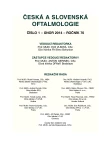Assessment of Postoperative Anterior-Posterior Shift of AcrySof SP Lens in Time and Its Impact on Resulting Refraction
Authors:
R. Čech; K. Ressová; I. Prusáková
Authors‘ workplace:
Frýdku-Místku, primář MUDr. Radim
; Čech
; Beskydské oční centrum, Nemocnice ve
Published in:
Čes. a slov. Oftal., 70, 2014, No. 1, p. 10-14
Category:
Original Article
Práce byla prezentována formou přednášky během XIX. výročního kongresu SOS v Žilině dne 25. 10. 2013.
Overview
Purpose:
The present study assesses the anterior-posterior shift of the AcrySof SP intraocular lens in the eye between the third and fifteenth month after surgery.
Methods:
The observed set contained a total of 241 eyes operated for cataract at Beskydské oční centrum (Beskydy Eye Centre; BOC), Frýdek-Místek hospital from 7 February 2007 to 7 April 2010. All surgeries were performed through microcoaxial phacoemulsification and a 2,2 mm incision, with intraocular lens (IOL) AcrySof type SP implanted. For each eye, we examined BCVA, as well as anterior chamber depth by optical biometry (IOL-Master, Carl Zeiss GmbH, Jena), 3 and 15 months after the surgery. Average depths were calculated and compared; and their variations converted from mm to diopters. Based on the BCVA results, we were able to determine optimum dioptric power of the IOL, which should have been implanted in the eye to ensure postoperative emmetropia. Averages of all values were calculated and results thereof compared.
Results:
We noted a slight average deepening of the anterior chamber depth (0,03 mm) causing a hypermetropic shift of 0,05 D, insignificant in terms of refraction. Though comparison of average optimum IOL values calculated based on examinations carried out 3 and 15 months after surgery, we ascertained an actual zero difference between the two values.
Conclusion:
Through our own calculations, we verified very good stability of the implanted hydrophobic acrylic SP AcrySof lenses in our set, with zero haptic angulation. There is de facto no anterior-posterior shift of the IOL between 3 and 15 months after surgery, and therefore no change in refraction noticeable by the patient.
Key words:
anterior-posterior shift, anterior chamber depth, optimum value of intraocular lens dioptric power, intraocular lens stability
Sources
1. Ang, G.S., Duncan, L.: Ultrasound biomicroscopic study of the stability of intraocular lens implants after phacoemulsification cataract surgery. A Ophthalmologica © [online]. 2012, roč. 90, č. 2, s. 168-172 [cit. 2013-04-23]. DOI: 10.1111/j.1755-3768.2010.01880.x. Dostupné z: http://onlinelibrary.wiley.com/doi/10.1111/j.1755-3768.2010.01880.x/full.
2. Drimtzias, E.G., Rokidi, S.G., Gartaginis, S.P.: Experimental Investigation on Mechanism of Hydrophilic Acrylic Intraocular Lens Calcification. American Journal of Ophthalmology [online]. 2011; 152, 5 : 824–833. [cit. 2013-06-03]. Dostupné z: http://www. sciencedirect.com/science/article/pii/S0002939411003205.
3. Eom, Y., Kang, S.Y., Song, J.S.: Comparison of the actual amount of axial movement of 3 aspheric intraocular lenses using anterior segment optical coherence tomography. J Cataract Refract Surg. [online]. 2013 : 00877–8 [cit. 2013-07-15]. DOI: 10.1016/ j.jcrs.2013.04.040. Dostupné z: http://www.ncbi.nlm.nih.gov/ pubmed/23954524.
4. Hayashi, K., Hayashi, H.: Comparison of the stability of 1-piece and 3-piece acrylic intraocular lenses in the lens capsule. J Cataract Refract Surg. [online]. 2005, roč. 31, č. 2, s. 337-42 [cit. 2013-06-23]. Dostupné z: http://www.ncbi.nlm.nih.gov/pubmed/15767155.
5. Holladay, J.T.: Intraocular lens power calculations for the refractive surgeon. Cataract Refract Surg, 1998, č. 3, s. 105–117.
6. CHang, D.F.: Comparative rotational stability of single-piece open-loop acrylic and plate-haptic silicone toric intraocular lenses. J Cataract Refract Surg, 2008; 34 : 1842–1827.
7. Johnem, T.: The Variety of Foldable Intraocular Lens Materials. J Cataract Refract Surg, 1996 : 22: Supplement 2.
8. Koeppl, Ch., Findl O., Kriechbaum K.: Postoperative change in effective lens position of a 3-piece acrylic intraocular lens. Journal of Cataract & Refractive Surgery [online]. 2003; 29, 10 : 1974–1979 [cit. 2013-04-18]. Dostupné z: http://www.sciencedirect.com/ science/article/pii/S0886335002020497
9. Nejima, R., Myiai, T., Kataoka, Y.: Prospective Intrapatient Comparison of 6.0-Millimeter Optic Single-Piece and 3-Piece Hydrophobic Acrylic Foldable Intraocular Lenses. Ophtalmology [online]. 2006, roč. 113, č. 4, 585–590 [cit. 2013-05-12]. Dostupné z: http://www.sciencedirect.com/science/article/pii/S0161642006000030.
10. Pandita, D., Raj, S.M., Vasavada, V.A.: Contrast sensitivity and glare disability after implantation of AcrySof IQ Natural aspherical intraocular lens: Prospective randomized masked clinical trial. J Cataract Refract Surg [online]. 2007; 33 : 603–610 [cit.2013-03-08]. Dostupné z: http://www.sciencedirect.com/science/article/pii/ S0886335007000910.
11. Petternel, R., Menapace, J., Findl, O.: Effect of optic edge design and haptic angulation on postoperative intraocular lens position change. J Cataract Refract Surg [online]. 2004; 30 : 52–57 [cit. 2013-05-23]. Dostupné z: http://www.sciencedirect.com/science/ article/pii/S088633500300556X.
12. Skorkovská, Š., Michálek, J., Rubertová, M. et al.: Srovnání ultrazvukové a optické biometrie s ohledem na refrakci očí po operaci katarakty. Čes a Slov Oftal, 2004; 1 : 24–29.
13. Steinert, R.F.: Cataract surgery. In Saunders,Elsevier Health Sciences, 2010. ISBN 978-1-4160-3225-0. Dostupné z http://www.google.cz/books?hl=cs&lr=lang_en&id=NbM_MAd0dLIC&oi=fnd&pg=PP1&dq=Phaco-chop&ots=A3GvvX_ a4t&sig=rbWpFtr-Dpf68UbqckioH8RnIF4&redir_esc=y.
14. Ursell, P.: Anterior Capsule Stability in Eyes with Intraocular Lenses Made of Poly(methylmethacrylate), Silicone and Acrysof. J Cataract Refract Surg, 1997; 23.
15. Wirtisch, M.G.: Effect of haptic design on change in axial lens position after cataract surgery. J Cataract Refract Surg, 2004; 30 : 45–51.
Labels
OphthalmologyArticle was published in
Czech and Slovak Ophthalmology

2014 Issue 1
Most read in this issue
- Optic Disc Drusen – Current Diagnostic Possibilities
- Scleral Buckling for Rhegmatogenous Retinal Detachment
- Foveal Hypoplasia Detection by Optical Coherence Tomography
- Assessment of Postoperative Anterior-Posterior Shift of AcrySof SP Lens in Time and Its Impact on Resulting Refraction
